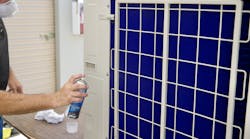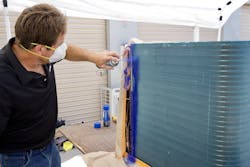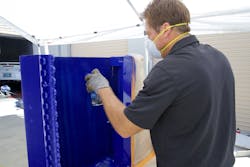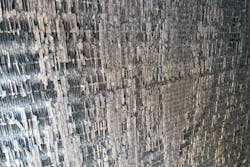By BOB MARTINELLI, RectorSeal LLC, Houston TX
Applying aftermarket protective coil coatings is critical to sustaining the full lifecycle of newly-installed HVAC equipment destined for corrosive environments, but many engineers and contractors don’t specify this important step.
Coastal areas are the most likely target markets for coil coatings. Salt spray from oceans can prematurely corrode outdoor HVAC coils in as little time as a year if not coated before use. Salt spray can travel as far inland as 10 miles, which creates a huge area of vulnerable equipment on North America’s seaboard.
Protecting HVAC equipment with coil coatings isn’t a new concept. For many years, HVAC manufacturers have shipped newly-made coils directly to coating specialists as per the specification of engineers and contractors. Sensitive parts, such as electrical components, are masked-off, then coils are sprayed or electro-coated before the unit is shipped and installed in their corrosive environment destination.
What is new today are coatings that have been packaged in game-changing, convenient easy-to-use aerosol cans. Contractors can now coat coils in their shop or onsite before installation. This skips past the time and effort required to send a coil or the entire unit out for factory-applied coatings. Furthermore, contractors can create an entire do-it-yourself (DIY) coating niche that requires minimal experience or training.
When selecting a coil coating it is important to make sure that the product has passed ASTM B117 test standards for salt spray. It also should have multiple marine and industrial ASTM test standard listings for resisting ultraviolet (UV) rays, acid rain, high concentrations of urban vehicle emission air pollutants and other outdoor contaminants. It’s also important to choose a brand that with a long history and reputation for providing OEM-approved, factory-applied coil coatings.
When To Use A DIY Coating
Deciding when to use a coating specialist versus a contractor with field-applied DIY aerosol applications, usually depends on the project scope. For example, it’s more economical to request the manufacturer ship 200 new split system condensers to a factory-coating specialist if the units are destined for a beachfront condo complex. However, a contractor using DIY aerosol protective coatings for a beachfront home’s condenser(s) can be very economical and reduce the installation time versus shipping the product(s) to and from a coating specialist. As for unit size, typically any HVAC coil in a system 10 tons or smaller is perfect DIY coating application.
While coastal areas play a large part in coil corrosion, other potential areas where premature coil corrosion can occur include:
- Urban areas, and particularly airports, which have heavy concentrations of airborne vehicle emissions;
- Buildings near or located inside properties of waste water treatment plants;
- Any heavy industrial area that emits airborne chemicals;
- Restaurants where cooking grease particulates are exhausted in close proximity to the HVAC rooftop system.
Heat Transfer and Static Pressure Considerations
Many engineers and contractors have questions about how the coatings will effect a coil’s heat transfer performance. While some coating formulas might be borrowed from other industries, only coatings designed specifically for HVAC coils should be used, because they’re formulated for negligible heat transfer loss. These specialty coil coatings are typically only 1.4-ml thick or less, versus other thicker industrial coatings that can negatively affect heat transfer.
Static pressure is also a consideration, but coatings designed specifically for HVAC coils don’t increase the pressure drop through the coil. Instead, they may even lower the pressure drop versus an uncoated coil, because less static pressure-increasing contaminants will reside or adhere to the coil surfaces.
Of course, there’s more to consider about corrosion than its effect on static pressure. Corrosion, especially from salt, can create formicary and pitting processes that ultimately lead to leaks.
How DIY Coatings Are Applied
Contractors can apply DIY coil coatings in the field, or in their shop. Obviously, shop-applied coatings are preferred, because of the controlled environment for temperature, humidity with no challenges from wind.
“Clean” and “dry” are key to a good coating adhesion. The first step mandates cleaning the coil with a foaming, non-acid, non-caustic coil cleaner and then thoroughly rinsing the coil. Many contractors believe that new coils are clean. However, most new coils have machining oil residue from the manufacturing process that must be fully removed for successful coating adhesion.
While contractor-applied coatings are designed for new units, if an older unit that has already been exposed to corrosion is being coated, it should be treated first with a purposely-formulated salt and oil removing coil cleaner.
Once the coil has been cleaned and is completely dry, the electrical contacts, moving parts, valves, compressors and other parts not to be coated, are masked off with blue painter’s tape, which doesn’t leave a residue and is easily removed. It might also be beneficial to coat the unit’s compressors and accumulator to minimize the corrosive environment’s effect on these key components.
The coating stream is sprayed approximately four inches away from the coil in similar movements to spray painting. Some coatings are clear, which allow the coil to appear aesthetically uncoated (See image at top.) Other coatings are blue, for when the applicator prefers to visibly track even coverage of the sprayed area. Drying times for touching is 10 minutes; handling is 20 minutes; recoating is 30 minutes; and a full cure typically requires 48 hours.
During use, the corrosive elements in the air will attack the coil’s coating instead of the copper and aluminum surfaces. For this reason, coatings may need a re-application every five to 10 years depending on the environment’s corrosiveness.
Coatings are essential for coastal areas, however engineers and contactors should also consider the prospect of coating coils in high air pollution areas such as urban centers and airports also. In any corrosive situation, coatings will help improve the efficiency of the unit and maximize the unit’s useful life.
Based in Houston, the author is Director of Corporate Development at RectorSeal. Modine Coatings recently named RectorSeal the master distributor for GulfCoat™, a new coil coating packaged in aerosol cans for contractors to apply to extend the lifecyle of coils and HVAC equipment exposed to coastal area salt, urban air pollution and corrosive chemicals. Contact: [email protected].












